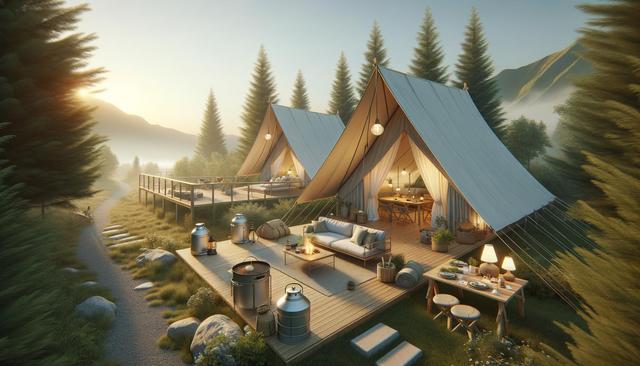What Are Tent Homes?
Tent homes are semi-permanent or temporary dwellings that use durable tent-like structures as living spaces. Unlike traditional camping tents, these are often designed with longevity and comfort in mind. They can vary in size, materials, and complexity—from minimalistic canvas coverings to elaborate setups with insulation, flooring, and electricity. Tent homes offer a middle ground between traditional homes and mobile lifestyles, making them attractive to individuals who value mobility, sustainability, or low-cost living. The concept has been adopted in various contexts, such as eco-resorts, disaster relief housing, and alternative housing communities.
People choose tent homes for a variety of reasons, such as escaping high housing costs, reducing their carbon footprint, or embracing a minimalist lifestyle. For some, it’s a temporary solution; for others, it becomes a long-term way of living. The appeal lies in the simplicity and freedom tent homes provide, often requiring less maintenance and allowing for easy relocation if needed.
Benefits of Living in a Tent Home
The benefits of tent homes are numerous and depend largely on the individual’s goals and lifestyle. One of the most significant advantages is cost. Building or purchasing a tent home is generally far less expensive than traditional housing options. Additionally, operating costs are lower, especially if the home is off-grid.
Other advantages include:
- Mobility: Tent homes are easier to relocate compared to traditional houses or even RVs.
- Sustainability: Many tent homes use eco-friendly materials and promote lower energy consumption.
- Reduced footprint: Living in a tent home encourages a more minimalist lifestyle with fewer possessions and less waste.
Besides economic and environmental benefits, tent homes often provide a deeper connection to nature. Whether located in a forest, desert, or near the mountains, they allow residents to live closer to natural landscapes and enjoy outdoor life more regularly.
Challenges and Considerations
While tent homes offer many benefits, they also come with challenges that need to be carefully considered. One major concern is weather protection. Tent structures, even those made from high-quality materials, may not provide the same level of insulation or protection from extreme weather as traditional homes. This can lead to discomfort during very hot, cold, or wet seasons.
Security is another consideration. Tent homes are typically easier to break into than conventional buildings, which may require additional measures for protection and peace of mind. Other logistical concerns include access to utilities like water, electricity, and waste disposal. Depending on location, these services may be limited or require alternative solutions such as solar panels, composting toilets, and rainwater collection systems.
Before transitioning to a tent home, it’s essential to research applicable local laws and zoning regulations. In many areas, living in a tent long-term may not be legally permitted or could require permits. Understanding these rules can help avoid legal complications and ensure a smoother experience.
Design and Features of Modern Tent Homes
Modern tent homes are a far cry from basic camping tents. Designers and manufacturers have responded to growing demand with innovative materials and features that enhance comfort and durability. Popular materials include heavy-duty canvas, PVC, and reinforced polyester. These are often combined with wooden or metal frames to provide structure and longevity.
Common features found in tent homes include:
- Insulated flooring and weather-resistant walls
- Windows and ventilation systems
- Solar-powered lighting and appliances
- Integrated bathroom and kitchen areas
- Deck space for outdoor living
Some people customize their tent homes extensively, integrating smart home technology, energy-efficient appliances, and furniture designed for small spaces. These enhancements make tent living more viable year-round and elevate the experience from basic shelter to a comfortable, sustainable home.
The design flexibility also allows individuals to express their creativity. Whether styled like a rustic lodge or a modern retreat, tent homes can be tailored to match personal preferences while retaining functionality.
Who Are Tent Homes For?
Tent homes appeal to a wide range of people. Digital nomads, nature lovers, retirees, and even small families are exploring this lifestyle. For those working remotely, a tent home offers a quiet, inspiring environment away from urban distractions. Retirees may find the simplicity and cost-effectiveness appealing, especially for seasonal or part-time living.
They’re also gaining interest from environmental advocates and people interested in intentional communities. By living in low-impact dwellings in shared spaces, individuals can cultivate a communal lifestyle that emphasizes collaboration, sustainability, and shared resources. Tent homes can also serve as transitional housing for people recovering from natural disasters or financial hardship, offering a dignified and affordable living solution.
In educational or recreational settings, tent homes can be part of eco-camps, research stations, or youth programs. Their versatility means they can be adapted to serve a variety of needs, from short-term stays to long-term commitments.
Conclusion: A Lifestyle Worth Considering
For those seeking a more affordable, sustainable, and flexible way of living, tent homes present a compelling option. While not without challenges, the benefits in terms of cost savings, environmental impact, and lifestyle simplicity make them worth considering. Whether used as a temporary retreat, a seasonal residence, or a full-time home, tent homes offer a unique housing solution that aligns with evolving priorities around sustainability and personal freedom. As housing trends continue to shift, tent homes are likely to play an increasingly important role in how we think about where—and how—we live.


